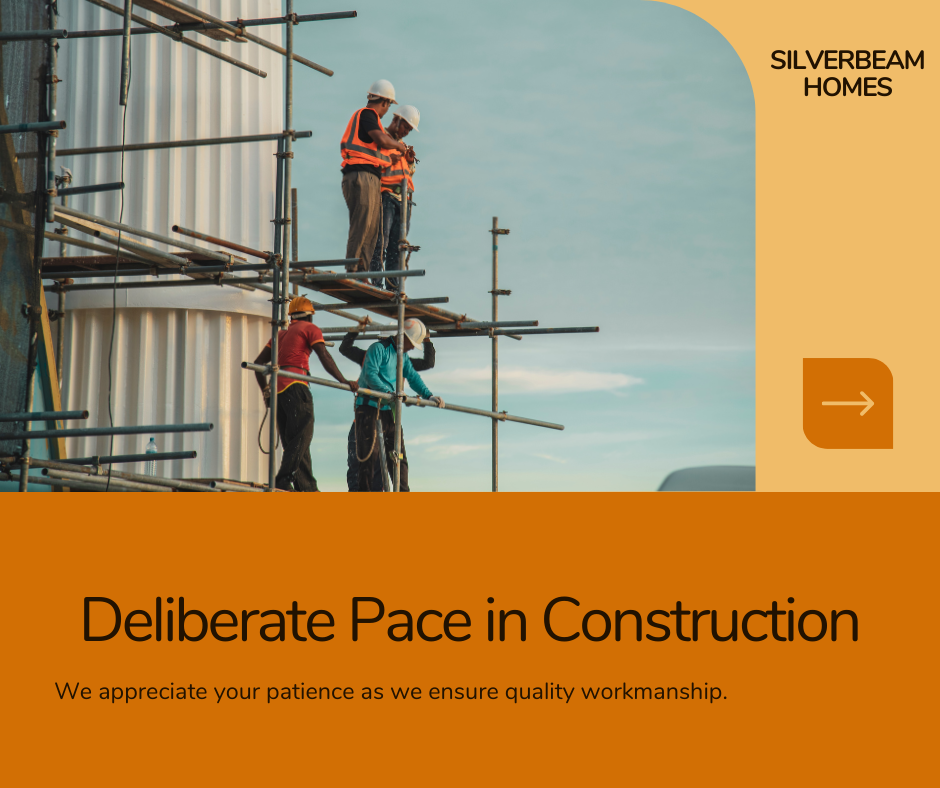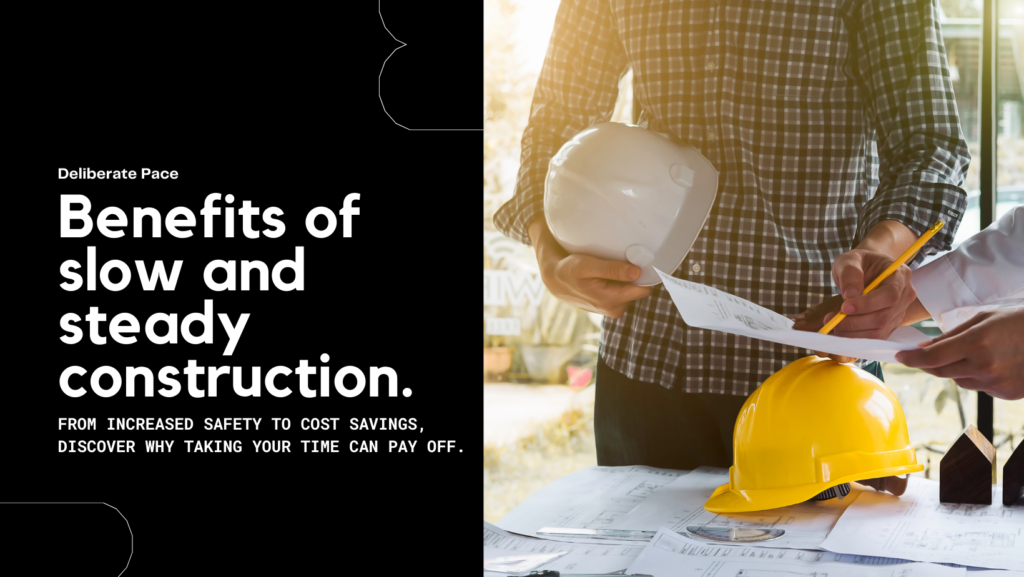
In the fast-paced world of construction, where timelines often dictate progress, the concept of working slowly may seem counterintuitive. However, as we delve deeper into the dynamics of construction sites, it becomes evident that there are various factors and implications associated with this approach. From prioritizing quality and safety to navigating complex tasks and external constraints, the decision to slow down construction work is multifaceted and nuanced. In this article, we explore the underlying causes and implications of working slowly in construction, shedding light on the intricacies of this deliberate approach.
Working Slowly in Construction: Understanding the Implications
Quality Focus
Slowing down construction work intentionally can be a strategic decision aimed at prioritizing quality over speed. Rushing through tasks in the construction process can often lead to errors and compromises in craftsmanship. When our workers work at a slower pace, they have the opportunity to focus more intently on each detail of the project. This heightened attention to detail enables them to meticulously execute each aspect of the construction process, resulting in structures that are not only aesthetically pleasing but also structurally sound and durable. Whether it’s ensuring precise measurements, carefully aligning materials, or meticulously finishing surfaces, the extra time and attention invested in each step contribute to the overall quality and integrity of the final product. In essence, by working slowly, we can elevate the standard of craftsmanship, delivering better-built structures that stand the test of time.
Safety Measures
Construction sites are notorious for their inherent hazards, ranging from precarious heights to heavy machinery and hazardous materials. Slowing down work on construction sites can serve as a critical safety precaution to mitigate these risks and prioritize the well-being of our workers. By adopting a deliberate pace, we have the opportunity to adhere more strictly to established safety protocols and procedures.
Working at a slower pace allows us to take the necessary time to assess potential hazards and implement appropriate safety measures before proceeding with tasks. This may include conducting thorough safety inspections, ensuring proper equipment usage and maintenance, and coordinating effectively with colleagues to minimize risks.
Moreover, a slower pace enables us to maintain heightened awareness of our surroundings, reducing the likelihood of accidents caused by oversight or haste. Whether it’s navigating through cluttered work areas, operating heavy machinery, or working at heights, the ability to work methodically and attentively can significantly decrease the risk of workplace incidents and injuries.
In addition, a deliberate approach to work allows our workers to address safety concerns promptly and effectively. If hazards are identified during the course of work, having the flexibility to slow down operations enables workers to take the necessary time to address and rectify these issues before they escalate into more serious safety hazards.
Complexity of Tasks

In the realm of construction, certain tasks demand a slower pace due to their inherent complexity and the level of precision and care they require. These tasks often involve intricate architectural designs, specialized installations, or delicate procedures that necessitate meticulous attention to detail and careful execution.
One example of such tasks is the installation of intricate architectural features, such as ornate moldings, decorative facades, or elaborate interior finishes. These elements often involve intricate patterns, complex geometries, and precise alignments, requiring construction workers to work slowly and methodically to ensure flawless execution. Rushing through these tasks could result in misalignments, inaccuracies, or damage to the delicate materials, compromising the overall quality and aesthetic appeal of the finished structure.
Similarly, specialized installations, such as high-tech mechanical systems, advanced electrical wiring, or sophisticated HVAC systems, demand a slower pace to ensure proper integration and functionality. These installations often involve intricate components, complex wiring diagrams, and precise connections that require careful coordination and meticulous installation techniques. Working slowly allows our workers to follow detailed instructions, troubleshoot potential issues, and ensure that each component is installed correctly to achieve optimal performance.
Moreover, delicate procedures, such as concrete pouring, structural welding, or glass installation, require a slower pace to minimize the risk of errors and ensure structural integrity. These tasks involve working with materials that are sensitive to temperature, humidity, and other environmental factors, requiring precise timing and execution. Working slowly allows us to monitor these conditions closely, adjust our techniques as needed, and maintain the quality and integrity of the finished product.
Adverse Conditions
Extreme weather conditions and challenging terrain pose significant challenges to construction projects, often necessitating a slower pace of work to ensure both worker safety and the integrity of the project. In regions prone to severe weather events construction activities may need to be slowed or temporarily halted to protect workers from hazardous conditions such as strong winds, heavy rainfall, or extreme temperatures. Similarly, construction sites situated in rugged terrain or unstable ground conditions require careful navigation and preparation, with workers proceeding cautiously to mitigate the risk of accidents or structural failures. By adjusting the pace of work to accommodate environmental challenges, our teams can prioritize the safety of their workforce and safeguard the long-term success of the project.
Resource Constraints
Limited availability of resources, including materials and equipment, can significantly hinder the progress of construction projects, leading to a slower pace of work. When essential supplies or equipment are scarce or unavailable, construction activities may be forced to come to a halt, causing delays and disruptions to the project timeline. Whether it’s waiting for deliveries of crucial building materials, such as steel, concrete, or specialized components, or dealing with equipment breakdowns requiring repairs or replacement parts, the inability to access necessary resources can impede productivity and slow down construction operations. As a result, construction teams must carefully manage their inventory, anticipate potential shortages or equipment failures, and implement contingency plans to minimize the impact of resource constraints on project progress.
Regulatory Compliance
Compliance with building codes, environmental regulations, and permit requirements is paramount in the construction industry and often necessitates a deliberate and cautious approach to work. Ensuring full adherence to these regulations may require our construction teams to slow down their pace of work to meticulously review plans, implement specific design features, and incorporate required safety measures. From obtaining the necessary permits before commencing construction to conducting regular inspections throughout the project lifecycle, adhering to regulatory standards is essential to avoid potential legal issues, fines, or project delays. By taking the time to navigate the intricate web of regulations and ensuring strict compliance at every stage of the construction process, teams can mitigate risks, uphold industry standards, and safeguard the integrity and legality of our projects.
Labor Issues
Shortages of skilled labor or internal conflicts within the construction workforce can significantly disrupt project timelines, resulting in delays and a slower pace of construction. When faced with a scarcity of qualified workers or interpersonal conflicts among team members, construction projects may experience setbacks as teams struggle to maintain productivity levels. The process of hiring and training new workers to fill skill gaps or resolve workforce disputes can be time-consuming, diverting resources and attention away from project tasks. Moreover, unresolved conflicts within the workforce can create tension and hinder collaboration, further impeding progress. By addressing labor shortages proactively through recruitment efforts and fostering a positive work environment that promotes effective communication and teamwork, construction teams can mitigate the impact of workforce challenges and maintain momentum towards project completion.
Client Preferences
In certain instances, clients may opt for a slower pace of construction to align with their specific scheduling preferences or minimize disruptions to their daily routines. By opting for a slower tempo, clients can mitigate inconveniences such as noise, dust, and restricted access, allowing them to carry on with their regular activities with minimal disruption. Additionally, a more leisurely construction pace provides clients with ample time to review progress, make informed decisions, and ensure that their vision for the project aligns seamlessly with the evolving construction process. Ultimately, prioritizing client preferences for a slower construction pace fosters a collaborative and client-centric approach, enhancing satisfaction and fostering positive relationships between construction teams and their clientele.
While working slowly in construction may seem counterintuitive to efficiency, it can be a strategic approach to ensure safety, quality, and compliance with various factors influencing the construction process. By understanding the implications and underlying causes of this deliberate pace, construction professionals can make informed decisions that balance speed with precision, ultimately leading to successful project outcomes. As we navigate the complexities of construction sites, let us recognize the value of thoughtful and deliberate workmanship, where the mantra of “slow and steady” paves the way for lasting quality and excellence.
read more


Recent Comments